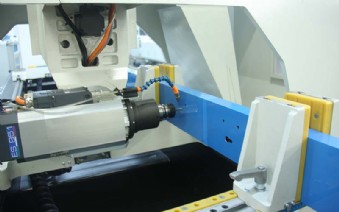-

Company
Product
ALUMINIUM MACHINES
PORTABLE MITER SAWS FOR ALUMINUM
PORTABLE COPY ROUTER MACHINES FOR ALUMINIUM
PORTABLE END MILLING MACHINES FOR ALUMINIUM
AUTOMATIC MITER SAWS FOR ALUMINIUM
COPY ROUTER MACHINES FOR ALUMINIUM
END MILLING MACHINES FOR ALUMINIUM
ALUMINUM CORNER CRIMPING MACHINE
DOUBLE MITRE SAWS FOR ALUMINIUM
AUTOMATIC SAWS FOR ALUMINIUM
BAR PROCESSING CENTERS
MACHINING CENTERS FOR ALUMINIUM COMPOSITE PANELS
NOTCHING SAWS
WEDGE CUTTING SAWS AND NOTCH CUTTING SAWS
MITER SAWS FOR ALUMINIUM
PVC PLASTIC MACHINES
PORTABLE MITER SAWS FOR PLASTIC
PORTABLE COPY ROUTER MACHINES FOR PLASTIC
PORTABLE END MILLING MACHINES FOR PLASTIC
MITER SAWS FOR PLASTIC
COPY ROUTERS FOR PLASTIC
END MILLING MACHINES FOR PLASTIC
WELDING MACHINES FOR PLASTIC
CORNER CLEANING MACHINES FOR PLASTIC PROFILES
DOUBLE MITRE SAWS FOR PLASTIC
BAR PROCESSING CENTERS
GLAZING BEAD SAWS
AUTOMATIC MITRE SAWS FOR PLASTIC
METAL MACHINES
MANUAL METAL SHEET BENDING MACHINE
MANUAL BENDING MACHINES
HYDRAULIC BENDING MACHINES
NON MANDREL BENDERS
PLATE BENDING MACHINES
BORDERING AND TRIMMING MACHINES
HORIZONTAL PRESSES
BELT GRINDING MACHINES
PIPE NOTCHING MACHINES
PIPE POLISHING MACHINES
LASER CUTTING MACHINES
PRESS BRAKES
VERTICAL TURNING CENTERS
MACHINING CENTERS
WOOD MACHINES
GLASS MACHINES
ROBOTICS SPECIAL MACHINERY
Service
Blog
Contact
Blog
- Home
- Blog
- PVC WINDOW MACHINE
- WINDOW MANUFACTURING MACHINES
WINDOW MANUFACTURING MACHINES

Window manufacturing machines: precision, automation, and ROI for modern shops
Introduction
In residential, commercial, and high-rise projects, windows are mission-critical for daylight, ventilation, energy performance, safety, and design. To deliver on all of these, shops rely on window manufacturing machines that saw, cut, drill, mill, groove, slot, engrave, mark, weld, clean, and assemble aluminum, PVC, and wood profiles with high repeatability.
What is a window manufacturing machine?
A window manufacturing machine is specialized industrial equipment that combines CNC control, automation, and application-specific tooling to execute every step of bar preparation, hardware routing, PVC welding, corner cleaning, frame/sash assembly, glazing, and quality control. The result: faster cycles, less scrap, consistent quality, and full traceability.
Core machine types
-
Profile machining centers
Multi-axis machining for aluminum/PVC: milling, drilling, grooving, drainage slotting, hardware pockets, engraving and part marking. Tool changers, automatic clamping, barcode/QR workflows. -
Double-mitre saws
Accurate 45°/90° (and variable-angle) cuts on jambs, rails, sashes, mullions, transoms, glazing beads; length optimization and digital stops. -
PVC welding machines
1–4 head welders for frames/sashes with controlled temperature/pressure/time and stable bead quality. -
Corner cleaners/deburring machines
Automatic removal of weld excess on PVC corners for a clean finish. -
Hardware routing/drainage stations
Processing of lock cases, handle holes, hinge prep, drainage/weep features. -
Automated feeding/marking/assembly lines
Bar magazines, push-feeders, inkjet/engraving marking, frame assembly and automated screwdriving.
Typical production flow
-
Bar cutting (yield optimization).
-
CNC machining (hardware, drainage, engraving).
-
PVC welding or aluminum/wood assembly (cleats, crimping, bonding).
-
Corner cleaning/deburring.
-
Glazing and bead installation.
-
QC, marking, packaging (codes, labels, traceability).
What to compare before you buy
-
Axis travels, rigidity, spindle power, tool capacity.
-
Cut lengths/angles on double-mitre saws.
-
PVC welder capacity and repeatability.
-
Auto-loading, tool changers, measurement systems.
-
Software (macro libraries, cut-list import, MES/ERP links).
-
Chip/dust extraction, safety, CE compliance.
-
Total cost of ownership: throughput, maintenance, tooling, training.
Safety, health, environment
Aluminum/PVC/wood machining generates chips and fine dust. Use dedicated extraction, PPE (glasses, gloves, respirators), avoid compressed-air blow-offs, follow safety data sheets, and recycle offcuts.
Maintenance and quality
-
Preventive: lubrication, backlash checks, clamping calibration, software updates.
-
Tooling: sharpening/replacement; choose carbide/PCD by material.
-
Quality: gauges, corner/weld tests, SPC tracking.
Trends
Flexible automation, robotic loading, end-to-end traceability, digital twins, 5-axis capability, energy optimization, cycle analytics, deep BIM-ERP-MES integration.
Conclusion
Investing in high-performance window manufacturing machines upgrades productivity, quality, and margins. For aluminum, PVC, or wood, your shop gains precision, speed, safety, and profitability.
- window manufacturing machine
- window machine
- window production line
- profile machining center
- aluminum profile machining
- PVC window welder
- 4 head PVC welder
- corner cleaner
- double mitre saw
- hardware routing
- drainage slotting
- weep holes
- glazing bead cutting
- frame assembly
- sash assembly
- mullion transom
- barcode marking
- part marking
- CNC window machining
- aluminum windows
- PVC windows
- wood windows
- window fabrication
- cutting drilling milling
- grooving slotting
- engraving marking
- automatic loading
- cut list optimization
- quality control windows
- traceability windows
- industrial joinery
- façade curtain wall
- window hardware
- hinge prep
- handle holes
- lock case routing
- tool changer
- spindle power
- chip extraction
- safety compliance
- CE marking
- preventive maintenance
- SPC monitoring
 GERMANY
GERMANY ENGLISH
ENGLISH FRANCE
FRANCE SPAIN
SPAIN PORTUGAL
PORTUGAL








